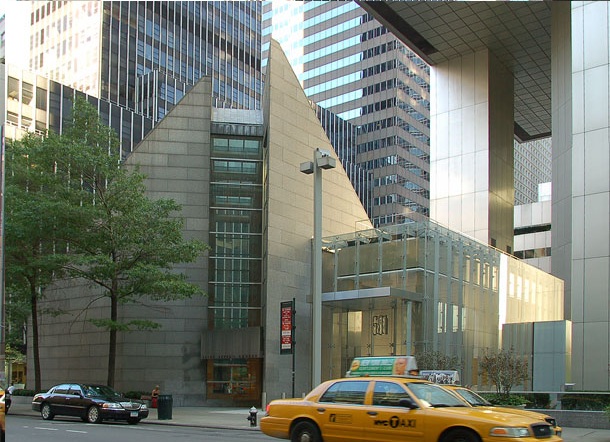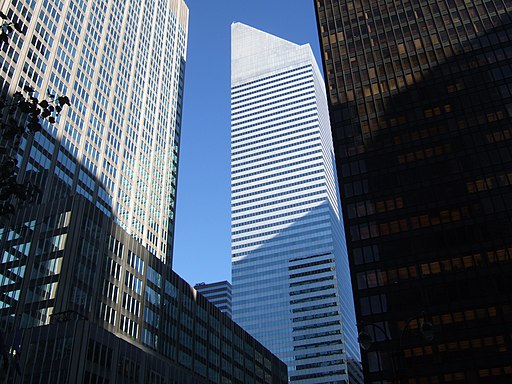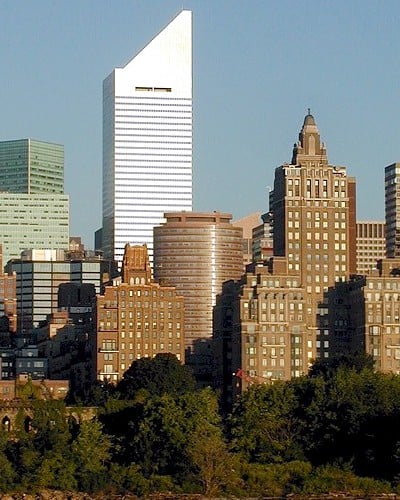This is an incredible story involving a barely averted disaster due to a critical design flaw in a NYC skyscraper. The former Citicorp Center (who changed their name to Citigroup), now better known as simply 601 Lexington Avenue—the skyscraper on stilts—is the culprit. The 7th tallest building in the world when it was built in 1977, it is recognizable for its 45-degree angled roof on the NYC skyline. In a classic case of “what-they-don’t-know-won’t-hurt-’em,” the discovery of the defect was kept hidden from the general public for 18 years.
The architect was the famed Hugh Stubbins, and his chief structural engineer was Bill LeMessurier, who happened to also be a close friend. The event is known to history as the Citicorp Engineering Crisis, an astonishing tale that details the unique circumstances which created a problem of epic proportions. We will discuss both the structural and ethical nature of this problem, those responsible, and the actions they took in response.
The Church

It all started with St. Peter’s Lutheran Church. The church needed a new building, and decided to look into selling the lot they currently occupied—but were thankful to be able to strike a deal with Citicorp developers. The church only occupied a small corner of the lot, and were willing to allow Citicorp to build there—as long as they rebuilt them a new church that was separate from the main structure, kept on the same location. If they could do that, then they were free to build around and above the corner of the lot the church occupied.
Enter our main character, William James LeMessurier, Jr., a well-educated and revered structural engineer heavily involved in the project. He came up with the idea of putting the skyscraper on “stilts,” and drew a simple sketch on a napkin at a Greek restaurant one evening. The stilts would have to be located in the center of the building instead of the four corners you might expect, because they had to avoid St. Peter’s corner of the lot.
The Design

The design plans for 601 Lexington Ave. were unique, and LeMessurier was a large part of them. The tower was to be 59-stories tall and ultimately reached a height of 915 feet, making it the 7th tallest skyscraper in the world (at the time). The stilts alone measure 112′ (feet) high each and are positioned underneath the centers of the towers’ outer edges, cantilevering 72′ feet outward from the core. In addition to hanging over the top of the church without disturbing it, the stilts also allowed for pouring a smaller foundation than would normally be necessary.
LeMessurier also designed the inverted chevron-shaped, load-bearing steel braces that are above the stilts and make up the steel-reinforced frame of the tower. They are designed to distribute tension from the upper stories caused by wind. The wind loads from each section are transferred into the center of the frame, where 60″ inch wide mass column transports extend the full height of the tower. The chevrons are not visible from the exterior but can be seen from inside. There were over 200 joints, however, which were designed to be welded together, for the added strength to withstand possible heavy winds. At the last minute during construction, the decision was made to use bolts instead of welding them, to save money. Though LeMessurier’s office received and accepted the change, LeMessurier himself said later he was unaware.
Additionally, LeMessurier was praised for his innovation of using a TMD, or tuned mass damper, to counteract swaying motion on the top levels. The mechanism is located at the rooftop in the mechanical space, and consists of a 30′ X 30′ X 6′ concrete block weighing 400 short tons, sitting on a steel plate in a pool of oil. It contains two spring mechanisms, one that counteracts north-south movement and one that counteracts east-west movement. It was the first skyscraper in the city to feature a TMD, and it was installed at a cost of $1 million.
The Design Flaws
Especially when showing off first-time innovations, there’s a proclivity for the unexpected—there were a few design flaws. The worst flaw of all was kept hidden from the general public, and a unique set of circumstances enabled that secret to be kept for nearly two decades. The first problem that occurred had to do with the roof. Originally, the roof was planned to be terraces for apartments. But strict zoning laws prohibited that, so the initial idea of 100-or-so apartments at the top had to be scrapped.
Since the building itself was actually designed to be energy efficient, the roof was prepared to be outfitted with solar panels. But the cost of those panels was significant, and Citicorp decided to do a study on it first to measure cost vs. savings. Ultimately, that idea was shelved but the design was kept. The angled roof made it stand out, comparatively, and the building was easily recognizable on the skyline. There was just one problem: Winter came, and sheets of ice and snow collected on the sloped roof, causing it to crash to the sidewalk below. Measures were eventually taken to stop that from happening, thankfully before anyone was hurt.
The Phone Call
In June of 1978, a year after the Citicorp Center debuted, an undergraduate student named Diane Hartley was writing her thesis on the Citicorp building. Her calculations uncovered some shocking information. Hartley double-checked her figures several times, then decided to reveal her frightening discovery within the thesis.
Her professor, David Billington, reviewed the calculations in Hartley’s thesis, and made a notation on the report questioning the numbers. Hartley was sure her calculations were right, so she decided to call her contact at LeMessurier, Joel S. Weinstein, to verify her numbers. She was told they were correct, and expressed her concerns. But she was reassured the building was structurally sound, and could withstand the winds. So she dropped the issue.
NYC only requires skyscrapers to account for perpendicular winds when calculating risk. This is because most buildings that are strong enough to handle perpendicular winds can also handle any quartering winds that might occur, since perpendicular winds are typically much stronger and more dangerous. But this was no ordinary building. Hartley had done thorough calculations, and the results had shown that the building was particularly vulnerable to being toppled over if high quartering winds occurred.
The Realization
Meanwhile, Weinstein, who took the call, wisely decided that perhaps he should at least mention it to LeMessurier. At first, LeMessurier dismissed the student’s claims. However, it stuck in the back of his mind, and after some time, he began to consider it seriously. He realized he had not factored in quartering winds, so he ran the numbers himself. Then he ran them again. And again.
Next, he pulled weather data and factored that in. Although LeMessurier’s initial feelings are not recorded, we can only assume images must have flashed through his mind of public humiliation. His career would most assuredly be over when the truth was revealed. LeMessurier had confirmed Hartley’s findings.
The Data & The Dilemma
LeMessurier was able to determine that a storm with winds strong enough to topple the building occurred in NYC once every 55 years on average. That was bad enough, but he had previously found another critical error: the bolted joints. Even with both of these issues, the TMD would theoretically render the risks negligible. However, the TMD would have to be functioning properly, and if the storm caused a power outage, it would be rendered useless.
The risk was completely unacceptable. What if something happened and people were hurt or killed? LeMessurier first ran tests of his own, and then visited a wind-tunnel expert he knew in Canada, who ran more tests and confirmed his fears. He agonized over his next move, even considering suicide by traveling 100 miles an hour into a bridge abutment. But he says he didn’t consider it very long, “Because if I did that I would miss finding out how the story ended—and that might be a rather stimulating experience.” The explanation conspicuously left out public safety issues. His ethics in handling the situation were shaky at best, yet he is known for them in history.
The Decision
Ultimately, he did the right thing—mostly. LeMessurier informed the architect’s attorney, his own liability insurance company, the architect, and the owner of Citicorp, who all decided to collaborate in secret. LeMessurier later told an audience of students at M.I.T. in 1995, “We had to cook up a line of bull, I’ll tell you. And white lies at this point are entirely moral,” citing the reason as not wanting to incite panic. But the fact of the matter is, all those “people in charge” were in on the subsequent coverup. Though few people were told at all, among them were building officials, Mayor Ed Koch, the Red Cross, the police, and the head of the welders’ union. These groups developed plans for repairing the structural inadequacy of the tower and implemented them.
The entire process of the repair work took place at night, after employees got off work. It stopped when they were about to enter the building in the morning. They were told the crew were performing “routine checks and repairs,” and there was nothing to be worried about. About halfway through the repairs, a storm just the right size, Hurricane Ella, was headed for New York. Luckily, Ella turned east and never hit land. But NYC was just hours away from evacuation, with the Red Cross and other emergency personnel standing by—and no one even knew it. Later, the Red Cross estimated that 200,000 people could have been killed, with hundreds of thousands potentially injured.
The Impact
Thanks to Mother Nature, as certainly no one else can be credited, it was the disaster-that-wasn’t. A couple of odd but strategic facts came into play during this time period. Number one, Citicorp and local officials (like Mayor Koch) collaborated and came up with an emergency evacuation plan for a “just-in-case” scenario, but purposely did not publish that plan—even though public safety was at risk. Secondly, the three major NYC newspapers were on strike during this time. Also, repairs were completed before the newspapers returned from the strike. And lastly, nothing happened to cause anyone to be questioned: No hurricane hit, and no structural failure occurred. All these things combined created the perfect “disguise” for the issues to remain a secret.
The Discovery
You’ll never guess how the story got out to the general public when it did. In a strange twist of fate, Joseph Morgenstern, a reporter for The New Yorker, was at a cocktail party one evening, listening to people’s stories. He overheard the story being told there, and called LeMessurier to ask for an interview. Perhaps LeMessurier consented to the interview because he was feeling guilty after all his efforts to keep the incident quiet, and after receiving several awards and praise for his structural design of the building. Whatever LeMessurier’s reasons, Morgenstern got the interview, and the story broke in 1995. Only after the BBC issued a documentary about the event did Diane Hartley (the former student) find out the impact of her discovery.
Afterward
When the public found out, they were not extremely impressed. The event was over, nothing had happened, and the danger had passed. But many in the field called LeMessurier a hero, showering him with praise and adoration. Others called LeMessurier’s ethics into question, while still others called him an example of someone ethical. LeMessurier died in 2007, but remains something of a hero to many engineers and architects. The Citicorp Engineering Crisis is now an ethical case-study for many architectural degree students.
How many other near-disasters may have “almost” happened? How many design flaws do we know nothing about? If city officials and community leaders will knowingly mislead the public over these types of issues, what does that say about their ethics and leadership? It’s important for us to hold people accountable for mistakes of this magnitude, especially when it concerns public safety. The Citicorp Engineering Crisis is a case to learn from.
Rochelle Harris is a passionate writer originally from Phoenix, AZ. who credits her success to integrity and determination. She has a great sense of humor, loves music and her family, and writes fiction and poetry in her spare time. She is excited about the New York experience and lifestyle! Follow Rochelle on Twitter at @LinguisticAnRky or get in touch at [email protected]



